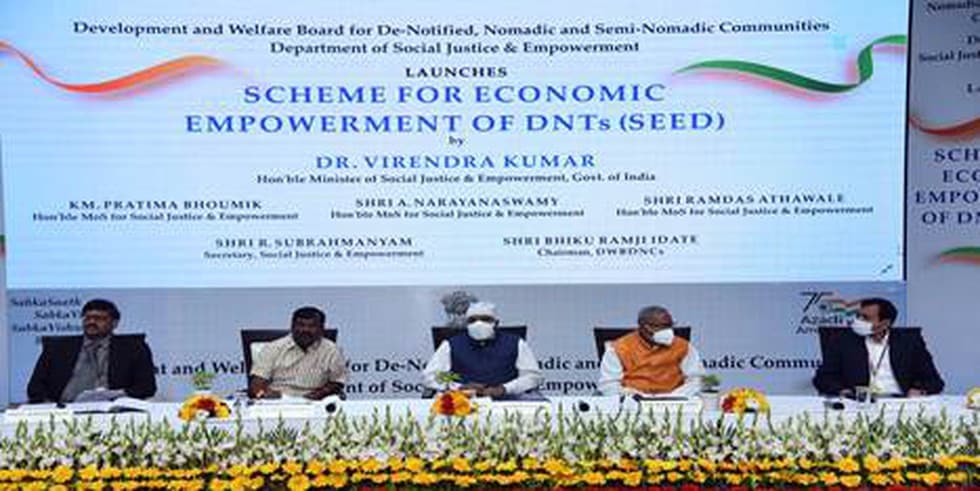SYLLABUS:
GS-2: Welfare schemes for vulnerable sections of the population by the Centre and States and the performance of these schemes; mechanisms, laws, institutions and Bodies constituted for the protection and betterment of these vulnerable sections.
Context:
The Centre in written reply informed the Rajya Sabha, about the formation of 3,438 Self-Help Groups (SHGs) comprising 46,067 members from De-notified, Nomadic, and Semi-Nomadic Communities under the SEED scheme.
More on the news:
- To coordinate efforts for the welfare of these communities, the ministry has also set up the Development and Welfare Board for De-notified, Nomadic and Semi-Nomadic Communities (DWBDNC).
- The board is working in collaboration with the National Backward Classes Finance and Development Corporation (NBCFDC), the National Scheduled Castes Finance and Development Corporation (NSFDC), and several NGOs to engage directly with the communities.
- However, the ministry clarified that the National Rural Livelihoods Mission (NRLM) does not maintain segregated data on DNT participation in SHGs at the national level.
- The SEED scheme is part of the government’s broader effort to ensure social justice and inclusion for groups that have traditionally remained outside the formal welfare net.
Scheme for Economic Empowerment of Denotified/Nomadic/Semi-Nomadic (DNTs) (SEED)
- It is a flagship welfare scheme launched in February 2022 by the Ministry of Social Justice and Empowerment.
- The scheme aims to economically empower De-notified, Nomadic, and Semi-Nomadic Tribes (DNT/NT/SNT) by improving their socio-economic conditions.
- The SEED scheme targets families with an annual income of ₹2.50 lakh or less, who are not availing benefits from similar schemes of the central or state governments.
The objectives of the Scheme are as follows: –
- To provide high-quality coaching to candidates from DNT communities to help them prepare for various competitive examinations.
- To provide health insurance coverage to DNT communities through the Pradhan Mantri Jan Arogya Yojana (PMJAY), implemented by the National Health Authority (NHA).
- To promote livelihood opportunities, the scheme supports community-level initiatives by building and strengthening small clusters of DNT/NT/SNT community institutions, in collaboration with State Rural Livelihood Missions (SRLMs) and the National Rural Livelihood Mission (NRLM).
- Financial assistance is also extended for the construction of houses for DNT community members under the Pradhan Mantri Awas Yojana (PMAY).
About Denotified, Nomadic and Semi-Nomadic Tribes
- DNTs, SNTs and NTs represent some of the most remote, marginalised, and historically oppressed communities in India.
- There is no official data on their population, but the Renke Commission (2008) put their population at 10.74 crores based on census 2001. Current estimates give a figure of 25 crore.
De-notified Tribes (DNTs)
- DNTs were once ‘notified’ as ‘born criminals’ by the British under a series of laws beginning with the Criminal Tribes Act of 1871.
- These discriminatory Acts, which criminalised entire communities based on hereditary occupation, were repealed by the Indian Government in 1952 after Independence.
- Consequently, such communities were “De-notified”, meaning they were no longer classified as criminal by law.
- Some of these de-notified communities were also nomadic in nature.
Nomadic and Semi-Nomadic Communities
These are communities that move from one place to another, instead of residing in one permanent location.
Semi-nomadic groups may stay in one area for longer periods but still do not have a fixed home.
Historically, Nomadic and De-notified Tribes lacked access to:
- Private land
- Home ownership
- Formal welfare services
Issue Regarding Classification of DNTs
Classification of DNTs refer to their formal recognition under India’s reservation categories. While some favour including DNTs under the existing SC, ST and OBC categories, other call for a separate reservation category for DNTs.
- Ex. According to Renke Commission 2008 almost 72% of nomadic tribes do not own Ration Cards.
Currently, there is no Central List of DNTs, like the existing lists for SCs, STs, and OBCs, leaving them without Constitutional or legal recognition.
- Ex. The Idate Commission highlighted that of 1526 DNT communities, 269 are not classified under any of the SC/ST/OBC categories.
Lack of socio-economic Identities: Some DNTs are included under SC, ST, or OBC categories in different states with no uniformity.
- Ex. Indian National Trust for Art and Cultural Heritage (INTACH) documented their professional hazards and the systemic invisibilisation of their identities.



